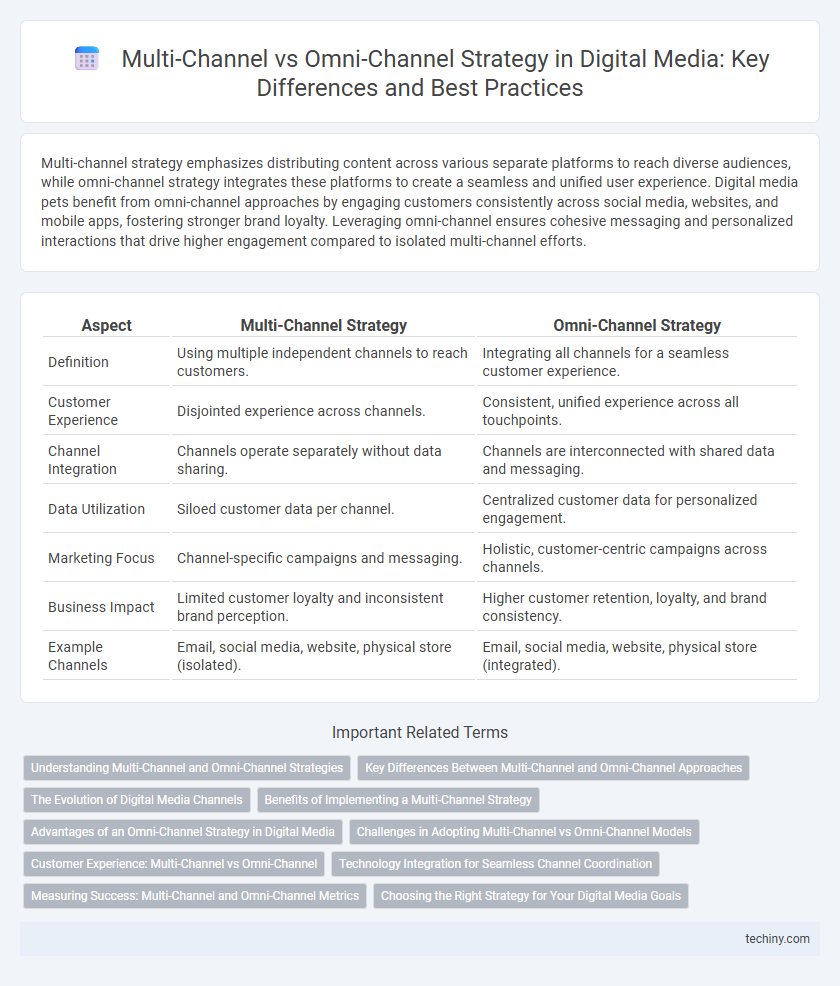Multi-channel strategy emphasizes distributing content across various separate platforms to reach diverse audiences, while omni-channel strategy integrates these platforms to create a seamless and unified user experience. Digital media pets benefit from omni-channel approaches by engaging customers consistently across social media, websites, and mobile apps, fostering stronger brand loyalty. Leveraging omni-channel ensures cohesive messaging and personalized interactions that drive higher engagement compared to isolated multi-channel efforts.
Table of Comparison
| Aspect | Multi-Channel Strategy | Omni-Channel Strategy |
|---|---|---|
| Definition | Using multiple independent channels to reach customers. | Integrating all channels for a seamless customer experience. |
| Customer Experience | Disjointed experience across channels. | Consistent, unified experience across all touchpoints. |
| Channel Integration | Channels operate separately without data sharing. | Channels are interconnected with shared data and messaging. |
| Data Utilization | Siloed customer data per channel. | Centralized customer data for personalized engagement. |
| Marketing Focus | Channel-specific campaigns and messaging. | Holistic, customer-centric campaigns across channels. |
| Business Impact | Limited customer loyalty and inconsistent brand perception. | Higher customer retention, loyalty, and brand consistency. |
| Example Channels | Email, social media, website, physical store (isolated). | Email, social media, website, physical store (integrated). |
Understanding Multi-Channel and Omni-Channel Strategies
Multi-channel strategy involves engaging customers through multiple, separate channels such as social media, email, and websites without integration, leading to fragmented user experiences. Omni-channel strategy integrates all channels to create a seamless, unified customer journey across online and offline touchpoints. This approach enhances customer satisfaction and loyalty by ensuring consistent messaging and personalized interactions throughout every stage of the buying process.
Key Differences Between Multi-Channel and Omni-Channel Approaches
Multi-channel strategy involves using multiple independent channels like social media, email, and websites to reach customers, focusing on maximizing presence across each platform. Omni-channel strategy integrates all channels to provide a seamless, consistent customer experience, ensuring interactions across devices and touchpoints are interconnected. The key difference lies in the customer experience: multi-channel operates in silos, while omni-channel emphasizes unified engagement and data synchronization.
The Evolution of Digital Media Channels
Multi-channel strategy leverages multiple digital media channels independently to reach audiences across platforms like social media, email, and search engines, focusing on expanding touchpoints. Omni-channel strategy integrates these channels into a unified, seamless experience, ensuring consistent messaging and customer interactions across devices and platforms. The evolution of digital media channels has shifted from isolated channel management to interconnected ecosystems, driven by advancements in data analytics and customer experience technologies.
Benefits of Implementing a Multi-Channel Strategy
Implementing a multi-channel strategy in digital media enhances brand reach by engaging customers across various platforms such as social media, email, websites, and mobile apps, increasing overall visibility and customer touchpoints. This approach allows businesses to tailor content and messaging to specific channels, improving user experience and driving higher conversion rates through targeted campaigns. Multi-channel strategies also provide valuable data insights from each platform, enabling marketers to analyze audience behavior and optimize future marketing efforts for better ROI.
Advantages of an Omni-Channel Strategy in Digital Media
An omni-channel strategy in digital media enhances customer experience by creating seamless interactions across all digital touchpoints, including social media, websites, mobile apps, and email campaigns. This approach leverages unified data analytics to deliver personalized content and targeted advertisements, increasing engagement and conversion rates. By integrating channels into a cohesive ecosystem, brands improve customer retention and brand loyalty, driving higher lifetime value and stronger competitive advantage.
Challenges in Adopting Multi-Channel vs Omni-Channel Models
Multi-channel strategies face challenges such as inconsistent customer experiences and fragmented data across platforms, hindering a unified brand message. Omni-channel models demand advanced integration of customer touchpoints and real-time data synchronization, requiring significant investment in technology and organizational change. Balancing these complexities often determines the effectiveness of customer engagement and retention in digital media marketing.
Customer Experience: Multi-Channel vs Omni-Channel
Multi-channel strategy offers customers various platforms to interact with a brand independently, often leading to inconsistent user experiences across channels. Omni-channel strategy integrates all channels into a seamless, cohesive customer journey, enhancing satisfaction and loyalty through personalized and unified interactions. Businesses adopting omni-channel approaches see higher engagement rates and improved customer retention compared to traditional multi-channel efforts.
Technology Integration for Seamless Channel Coordination
Multi-channel strategies utilize distinct platforms independently, often leading to fragmented customer experiences due to limited technology integration between channels. Omni-channel strategies prioritize advanced technology integration--such as centralized CRM systems and unified data analytics--to enable seamless coordination across all platforms, ensuring consistent messaging and personalized interactions. This technological cohesion enhances overall customer engagement and drives better retention by providing a unified brand presence regardless of the channel used.
Measuring Success: Multi-Channel and Omni-Channel Metrics
Measuring success in multi-channel strategy involves tracking isolated metrics such as channel-specific click-through rates, conversion rates, and engagement levels, which provide insights into individual platform performance. Omni-channel strategy metrics emphasize unified customer experiences, focusing on cross-channel customer journey mapping, overall customer lifetime value, and seamless interaction consistency across devices. Key performance indicators for omni-channel approaches include increased customer retention rates, higher average order value from integrated touchpoints, and enhanced customer satisfaction scores reflecting cohesive brand engagement.
Choosing the Right Strategy for Your Digital Media Goals
Selecting the right strategy between multi-channel and omni-channel approaches depends on your digital media goals and customer engagement levels. Multi-channel strategies focus on maximizing reach across independent platforms, while omni-channel strategies prioritize seamless integration and consistent user experiences across all channels. Companies aiming for cohesive brand interaction and higher customer retention benefit most from an omni-channel approach that unifies messaging and analytics in real time.
Multi-Channel Strategy vs Omni-Channel Strategy Infographic

 techiny.com
techiny.com